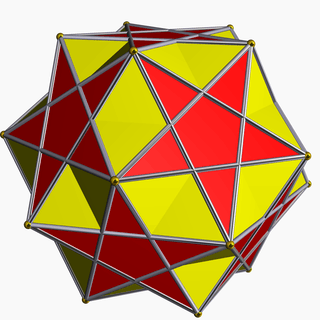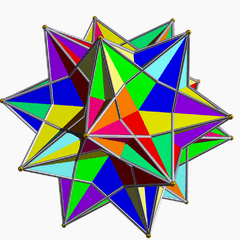Regular dodecahedron
| Regular Dodecahedron | |
|---|---|
 (Click here for rotating model) | |
| Type | Platonic solid |
| Elements | F = 12, E = 30 V = 20 (χ = 2) |
| Faces by sides | 12{5} |
| Conway notation | D |
| Schläfli symbols | {5,3} |
| Wythoff symbol | 3 | 2 5 |
| Coxeter diagram | |
| Symmetry | Ih, H3, [5,3], (*532) |
| Rotation group | I, [5,3]+, (532) |
| References | U23, C26, W5 |
| Properties | Regular convex |
| Dihedral angle | 116.56505° = arccos(−1/√5) |
 5.5.5 (Vertex figure) |
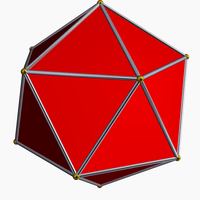 Regular icosahedron (dual polyhedron) |
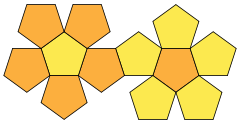 Net | |

A regular dodecahedron or pentagonal dodecahedron is a dodecahedron that is regular composed of twelve regular pentagonal faces, with three meeting at each vertex, and is represented by the Schläfli symbol {5,3}. It is one of the five Platonic solids. It has 20 vertices, 30 edges and 160 diagonals (60 face diagonals, 100 space diagonals).[1]
Dimensions
If the edge length of a regular dodecahedron is a, the radius of a circumscribed sphere (one that touches the regular dodecahedron at all vertices) is
and the radius of an inscribed sphere (tangent to each of the regular dodecahedron's faces) is
while the midradius, which touches the middle of each edge, is
These quantities may also be expressed as
where ϕ is the golden ratio.
Note that, given a regular dodecahedron of edge length one, ru is the radius of a circumscribing sphere about a cube of edge length ϕ, and ri is the apothem of a regular pentagon of edge length ϕ.
Area and volume
The surface area A and the volume V of a regular dodecahedron of edge length a are:
Two-dimensional symmetry projections
The regular dodecahedron has two special orthogonal projections, centered, on vertices and pentagonal faces, correspond to the A2 and H2 Coxeter planes.
| Centered by | Vertex | Edge | Face |
|---|---|---|---|
| Image |  |
 |
 |
| Projective symmetry |
[[3]] = [6] | [2] | [[5]] = [10] |
In perspective projection, viewed above a pentagonal face, the regular dodecahedron can be seen as a linear-edged schlegel diagram, or stereographic projection as a spherical polyhedron. These projections are also used in showing the four-dimensional 120-cell, a regular 4-dimensional polytope, constructed from 120 dodecahedra, projecting it down to 3-dimensions.
| Projection | Orthogonal projection | Perspective projection | |
|---|---|---|---|
| Schlegel diagram | Stereographic projection | ||
| Regular dodecahedron |  |
 |
 |
| Dodecaplex (120-cell) |
 |
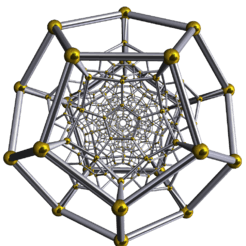 |
 |
Spherical tiling
The regular dodecahedron can also be represented as a spherical tiling.
 |
 |
| Orthographic projection | Stereographic projection |
|---|
Cartesian coordinates

| Vertex coordinates: | |
| The orange vertices lie at (±1, ±1, ±1) and form a cube (dotted lines). | |
| The green vertices lie at (0, ±1/ϕ, ±ϕ) and form a rectangle on the yz-plane. | |
| The blue vertices lie at (±1/ϕ, ±ϕ, 0) and form a rectangle on the xy-plane. | |
| The pink vertices lie at (±ϕ, 0, ±1/ϕ) and form a rectangle on the xz-plane. | |
| The distance between adjacent vertices is 2/ϕ, and the distance from the origin to any vertex is √3. ϕ = 1 + √5/2 is the golden ratio. | |
The following Cartesian coordinates define the 20 vertices of a regular dodecahedron centered at the origin and suitably scaled and oriented:[2]
- (±1, ±1, ±1)
- (0, ±1/ϕ, ±ϕ)
- (±1/ϕ, ±ϕ, 0)
- (±ϕ, 0, ±1/ϕ)
where ϕ = 1 + √5/2 is the golden ratio (also written τ) ≈ 1.618. The edge length is 2/ϕ = √5 − 1. The containing sphere has a radius of √3.
Facet-defining equations
Similar to the symmetry of the vertex coordinates, the equations of the twelve facets of the regular dodecahedron also display symmetry in their coefficients:
- ϕx ± y = ±ϕ2
- ϕy ± z = ±ϕ2
- ϕz ± x = ±ϕ2
Properties
- The dihedral angle of a regular dodecahedron is 2 arctan(ϕ) or approximately 116.5650512° (where again ϕ = 1 + √5/2, the golden ratio).
 A137218
A137218 - If the original regular dodecahedron has edge length 1, its dual icosahedron has edge length ϕ.
- If the five Platonic solids are built with same volume, the regular dodecahedron has the shortest edges.
- It has 43,380 nets.
- The map-coloring number of a regular dodecahedron's faces is 4.
- The distance between the vertices on the same face not connected by an edge is ϕ times the edge length.
- If two edges share a common vertex, then the midpoints of those edges form an equilateral triangle with the body center.
Geometric relations
The regular dodecahedron is the third in an infinite set of truncated trapezohedra which can be constructed by truncating the two axial vertices of a pentagonal trapezohedron.
The stellations of the regular dodecahedron make up three of the four Kepler–Poinsot polyhedra.
A rectified regular dodecahedron forms an icosidodecahedron.
The regular dodecahedron has icosahedral symmetry Ih, Coxeter group [5,3], order 120, with an abstract group structure of A5 × Z2.
Relation to the regular icosahedron
When a regular dodecahedron is inscribed in a sphere, it occupies more of the sphere's volume (66.49%) than an icosahedron inscribed in the same sphere (60.54%).
A regular dodecahedron with edge length 1 has more than three and a half times the volume of an icosahedron with the same length edges (7.663... compared with 2.181...), which ratio is approximately 3.51246117975, or in exact terms: 3/5(3ϕ + 1) or (1.8ϕ + 0.6).
A regular dodecahedron has 12 faces and 20 vertices, whereas a regular icosahedron has 20 faces and 12 vertices. Both have 30 edges.
Relation to the nested cube
A cube can be embedded within a regular dodecahedron, affixed to eight of its equidistant vertices, in five different positions.[3] In fact, five cubes may overlap and interlock inside the regular dodecahedron to result in the compound of five cubes.
The ratio of the edge of a regular dodecahedron to the edge of a cube embedded inside such a regular dodecahedron is 1 : ϕ, or (ϕ − 1) : 1.
The ratio of a regular dodecahedron's volume to the volume of a cube embedded inside such a regular dodecahedron is 1 : 2/2 + ϕ, or 1 + ϕ/2 : 1, or (5 + √5) : 4.
For example, an embedded cube with a volume of 64 (and edge length of 4), will nest within a regular dodecahedron of volume 64 + 32ϕ (and edge length of 4ϕ − 4).
Thus, the difference in volume between the encompassing regular dodecahedron and the enclosed cube is always one half the volume of the cube times ϕ.
From these ratios are derived simple formulas for the volume of a regular dodecahedron with edge length a in terms of the golden mean:
- V = (aϕ)3 · 1/4(5 + √5)
- V = 1/4(14ϕ + 8)a3
Relation to the golden rectangle
Golden ratio rectangles of ratio (ϕ + 1) : 1 and ϕ : 1 also fit perfectly within a regular dodecahedron.[4] In proportion to this golden rectangle, an enclosed cube's edge is ϕ, when the long length of the rectangle is ϕ + 1 (or ϕ2) and the short length is 1 (the edge shared with the regular dodecahedron).
In addition, the center of each face of the regular dodecahedron form three intersecting golden rectangles.[5]
History and uses



Regular dodecahedral objects have found some practical applications, and have also played a role in the visual arts and in philosophy.
Iamblichus states that Hippasus, a Pythagorean, perished in the sea, because he boasted that he first divulged "the sphere with the twelve pentagons."[6] In Theaetetus, a dialogue of Plato, Plato was able to prove that there are just five uniform regular solids; they later became known as the platonic solids. Timaeus (c. 360 B.C.), as a personage of Plato's dialogue, associates the other four platonic solids with the four classical elements, adding that there is a fifth solid pattern which, though commonly associated with the regular dodecahedron, is never directly mentioned as such; "this God used in the delineation of the universe."[7] Aristotle also postulated that the heavens were made of a fifth element, which he called aithêr (aether in Latin, ether in American English).
Regular dodecahedra have been used as dice and probably also as divinatory devices. During the hellenistic era, small, hollow bronze Roman dodecahedra were made and have been found in various Roman ruins in Europe. Their purpose is not certain.
In 20th-century art, dodecahedra appear in the work of M. C. Escher, such as his lithographs Reptiles (1943) and Gravitation (1952). In Salvador Dalí's painting The Sacrament of the Last Supper (1955), the room is a hollow regular dodecahedron. Gerard Caris based his entire artistic oeuvre on the regular dodecahedron and the pentagon, which is presented as a new art movement coined as Pentagonism.
In modern role-playing games, the regular dodecahedron is often used as a twelve-sided die, one of the more common polyhedral dice.
Some quasicrystals have dodecahedral shape (see figure). Some regular crystals such as garnet and diamond are also said to exhibit "dodecahedral" habit, but this statement actually refers to the rhombic dodecahedron shape.[8]
Immersive Media, a camera manufacturing company, has made the Dodeca 2360 camera, the world's first 360°, full motion camera which captures high-resolution video from every direction simultaneously at more than 100 million pixels per second or 30 frames per second. It is based on regular dodecahedron.
The popular puzzle game Megaminx is in the shape of a regular dodecahedron.
In the children's novel The Phantom Tollbooth, the regular dodecahedron appears as a character in the land of Mathematics. Each of his faces wears a different expression—e.g. happy, angry, sad—which he swivels to the front as required to match his mood.
Dodecahedron is the name of an avant-garde black metal band from Netherlands.[9]
Shape of the universe
Various models have been proposed for the global geometry of the universe. In addition to the primitive geometries, these proposals include the Poincaré dodecahedral space, a positively curved space consisting of a regular dodecahedron whose opposite faces correspond (with a small twist). This was proposed by Jean-Pierre Luminet and colleagues in 2003,[10][11] and an optimal orientation on the sky for the model was estimated in 2008.[12]
In Bertrand Russell's 1954 short story "The Mathematician's Nightmare: The Vision of Professor Squarepunt," the number 5 said: "I am the number of fingers on a hand. I make pentagons and pentagrams. And but for me dodecahedra could not exist; and, as everyone knows, the universe is a dodecahedron. So, but for me, there could be no universe."
Space filling with cube and bilunabirotunda
Regular dodecahedra fill space with cubes and bilunabirotundae (Johnson solid 91), in the ratio of 1 to 1 to 3.[13][14] The dodecahedra alone make a lattice of edge-to-edge pyritohedra. The bilunabirotundae fill the rhombic gaps. Each cube meets six bilunabirotundae in three orientations.
 Block model |
 |
 Lattice of dodecahedra |
 6 bilunabirotundae around a cube |
Related polyhedra and tilings
The regular dodecahedron is topologically related to a series of tilings by vertex figure n3.
| *n32 symmetry mutation of regular tilings: {n,3} | |||||||||||
|---|---|---|---|---|---|---|---|---|---|---|---|
| Spherical | Euclidean | Compact hyperb. | Paraco. | Noncompact hyperbolic | |||||||
 |
 |
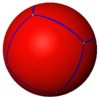 |
 |
 |
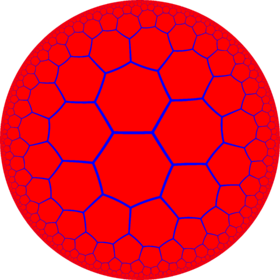 |
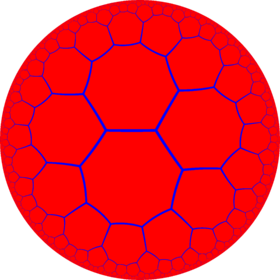 |
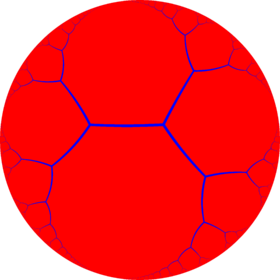 |
 |
 |
 |
 |
| {2,3} | {3,3} | {4,3} | {5,3} | {6,3} | {7,3} | {8,3} | {∞,3} | {12i,3} | {9i,3} | {6i,3} | {3i,3} |
The regular dodecahedron can be transformed by a truncation sequence into its dual, the icosahedron:
| Family of uniform icosahedral polyhedra | |||||||
|---|---|---|---|---|---|---|---|
| Symmetry: [5,3], (*532) | [5,3]+, (532) | ||||||
 |
 |
 |
 |
 |
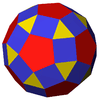 |
 |
 |
| {5,3} | t{5,3} | r{5,3} | t{3,5} | {3,5} | rr{5,3} | tr{5,3} | sr{5,3} |
| Duals to uniform polyhedra | |||||||
 |
 |
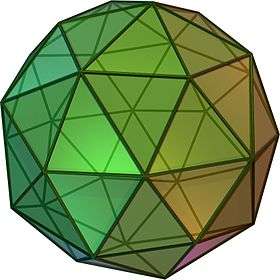 |
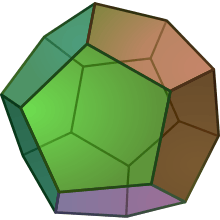 |
 |
 | ||
| V5.5.5 | V3.10.10 | V3.5.3.5 | V5.6.6 | V3.3.3.3.3 | V3.4.5.4 | V4.6.10 | V3.3.3.3.5 |
| Uniform octahedral polyhedra | ||||||||||
|---|---|---|---|---|---|---|---|---|---|---|
| Symmetry: [4,3], (*432) | [4,3]+ (432) |
[1+,4,3] = [3,3] (*332) |
[3+,4] (3*2) | |||||||
| {4,3} | t{4,3} | r{4,3} r{31,1} |
t{3,4} t{31,1} |
{3,4} {31,1} |
rr{4,3} s2{3,4} |
tr{4,3} | sr{4,3} | h{4,3} {3,3} |
h2{4,3} t{3,3} |
s{3,4} s{31,1} |
= |
= |
= |
||||||||
| Duals to uniform polyhedra | ||||||||||
| V43 | V3.82 | V(3.4)2 | V4.62 | V34 | V3.43 | V4.6.8 | V34.4 | V33 | V3.62 | V35 |
The regular dodecahedron is a member of a sequence of otherwise non-uniform polyhedra and tilings, composed of pentagons with face configurations (V3.3.3.3.n). (For n > 6, the sequence consists of tilings of the hyperbolic plane.) These face-transitive figures have (n32) rotational symmetry.
| n32 symmetry mutations of snub tilings: 3.3.3.3.n | ||||||||
|---|---|---|---|---|---|---|---|---|
| Symmetry n32 |
Spherical | Euclidean | Compact hyperbolic | Paracomp. | ||||
| 232 | 332 | 432 | 532 | 632 | 732 | 832 | ∞32 | |
| Snub figures |
 |
 |
 |
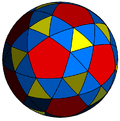 |
 |
 |
 |
 |
| Config. | 3.3.3.3.2 | 3.3.3.3.3 | 3.3.3.3.4 | 3.3.3.3.5 | 3.3.3.3.6 | 3.3.3.3.7 | 3.3.3.3.8 | 3.3.3.3.∞ |
| Gryro figures |
 |
 |
 |
 |
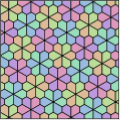 |
 |
 | |
| Config. | V3.3.3.3.2 | V3.3.3.3.3 | V3.3.3.3.4 | V3.3.3.3.5 | V3.3.3.3.6 | V3.3.3.3.7 | V3.3.3.3.8 | V3.3.3.3.∞ |
Vertex arrangement
The regular dodecahedron shares its vertex arrangement with four nonconvex uniform polyhedra and three uniform polyhedron compounds.
Five cubes fit within, with their edges as diagonals of the regular dodecahedron's faces, and together these make up the regular polyhedral compound of five cubes. Since two tetrahedra can fit on alternate cube vertices, five and ten tetrahedra can also fit in a regular dodecahedron.
Stellations
The 3 stellations of the regular dodecahedron are all regular (nonconvex) polyhedra: (Kepler–Poinsot polyhedra)
| 0 | 1 | 2 | 3 | |
|---|---|---|---|---|
| Stellation | 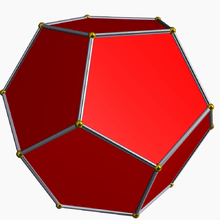 Regular dodecahedron |
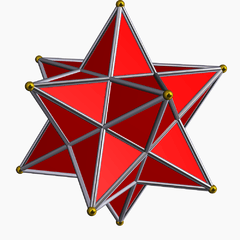 Small stellated dodecahedron |
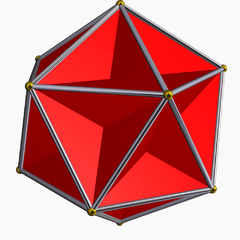 Great dodecahedron |
 Great stellated dodecahedron |
| Facet diagram |  |
 |
 |
 |
Dodecahedral graph
| Regular dodecahedron graph | |
|---|---|
|
A Hamiltonian cycle in a dodecahedron. | |
| Vertices | 20 |
| Edges | 30 |
| Radius | 5 |
| Diameter | 5 |
| Girth | 5 |
| Automorphisms | 120 (S5) |
| Chromatic number | 3 |
| Properties | Hamiltonian, regular, symmetric, distance-regular, distance-transitive, 3-vertex-connected, planar graph |
The skeleton of the dodecahedron (the vertices and edges) form a graph. It is one of 5 Platonic graphs, each a skeleton of its Platonic solid.
This graph can also be constructed as the generalized Petersen graph G(10,2). The high degree of symmetry of the polygon is replicated in the properties of this graph, which is distance-transitive, distance-regular, and symmetric. The automorphism group has order 120. The vertices can be colored with 3 colors, as can the edges, and the diameter is 5.[15]
The dodecahedral graph is Hamiltonian—there is a cycle containing all the vertices. Indeed, this name derives from a mathematical game invented in 1857 by William Rowan Hamilton, the icosian game. The game's object was to find a Hamiltonian cycle along the edges of a dodecahedron.
 |
See also
- 120-cell: a regular polychoron (4D polytope) whose surface consists of 120 dodecahedral cells.
- Pentakis dodecahedron
- Snub dodecahedron
- Truncated dodecahedron
References
- ↑ Sutton, Daud (2002), Platonic & Archimedean Solids, Wooden Books, Bloomsbury Publishing USA, p. 55, ISBN 9780802713865.
- ↑ Weisstein, Eric W. "Icosahedral group". MathWorld.
- ↑ http://mathworld.wolfram.com/images/eps-gif/DodecahedronCube_700.gif
- ↑ http://davidf.faricy.net/polyhedra/images/dodecarect.gif
- ↑ http://www.toshen.com/images/dodecahedronwithgoldrectang.gif
- ↑ Florian Cajori, A History of Mathematics (1893)
- ↑ Plato, Timaeus, Jowett translation [line 1317–8]; the Greek word translated as delineation is diazographein, painting in semblance of life.
- ↑ Dodecahedral Crystal Habit
- ↑ "Dodecahedron on Metal Archives".
- ↑ Dumé, Belle (Oct 8, 2003). "Is The Universe A Dodecahedron?". PhysicsWorld. Archived from the original on 2012-04-25.
- ↑ Luminet, Jean-Pierre; Jeff Weeks; Alain Riazuelo; Roland Lehoucq; Jean-Phillipe Uzan (2003-10-09). "Dodecahedral space topology as an explanation for weak wide-angle temperature correlations in the cosmic microwave background". Nature. 425 (6958): 593–5. arXiv:astro-ph/0310253
 . Bibcode:2003Natur.425..593L. doi:10.1038/nature01944. PMID 14534579.
. Bibcode:2003Natur.425..593L. doi:10.1038/nature01944. PMID 14534579. - ↑ Roukema, Boudewijn; Zbigniew Buliński; Agnieszka Szaniewska; Nicolas E. Gaudin (2008). "A test of the Poincaré dodecahedral space topology hypothesis with the WMAP CMB data". Astronomy and Astrophysics. 482 (3): 747. arXiv:0801.0006
 . Bibcode:2008A&A...482..747L. doi:10.1051/0004-6361:20078777.
. Bibcode:2008A&A...482..747L. doi:10.1051/0004-6361:20078777. - ↑ http://demonstrations.wolfram.com/DodecahedronAndBilunabirotunda/
- ↑ http://www.lcv.ne.jp/~hhase/memo/m09_08b.html
- ↑ Weisstein, Eric W. "Dodecahedral Graph". MathWorld.
External links
| Wikimedia Commons has media related to Regular dodecahedra. |
- Klitzing, Richard. "3D convex uniform polyhedra o3o5x – doe".
- Editable printable net of a dodecahedron with interactive 3D view
- The Uniform Polyhedra
- Origami Polyhedra – Models made with Modular Origami
- Dodecahedron – 3-d model that works in your browser
- Virtual Reality Polyhedra The Encyclopedia of Polyhedra
- K.J.M. MacLean, A Geometric Analysis of the Five Platonic Solids and Other Semi-Regular Polyhedra
- Dodecahedron 3D Visualization
- Stella: Polyhedron Navigator: Software used to create some of the images on this page.
- How to make a dodecahedron from a Styrofoam cube
| Fundamental convex regular and uniform polytopes in dimensions 2–10 | ||||||||||||
|---|---|---|---|---|---|---|---|---|---|---|---|---|
| Family | An | Bn | I2(p) / Dn | E6 / E7 / E8 / E9 / E10 / F4 / G2 | Hn | |||||||
| Regular polygon | Triangle | Square | p-gon | Hexagon | Pentagon | |||||||
| Uniform polyhedron | Tetrahedron | Octahedron • Cube | Demicube | Dodecahedron • Icosahedron | ||||||||
| Uniform 4-polytope | 5-cell | 16-cell • Tesseract | Demitesseract | 24-cell | 120-cell • 600-cell | |||||||
| Uniform 5-polytope | 5-simplex | 5-orthoplex • 5-cube | 5-demicube | |||||||||
| Uniform 6-polytope | 6-simplex | 6-orthoplex • 6-cube | 6-demicube | 122 • 221 | ||||||||
| Uniform 7-polytope | 7-simplex | 7-orthoplex • 7-cube | 7-demicube | 132 • 231 • 321 | ||||||||
| Uniform 8-polytope | 8-simplex | 8-orthoplex • 8-cube | 8-demicube | 142 • 241 • 421 | ||||||||
| Uniform 9-polytope | 9-simplex | 9-orthoplex • 9-cube | 9-demicube | |||||||||
| Uniform 10-polytope | 10-simplex | 10-orthoplex • 10-cube | 10-demicube | |||||||||
| Uniform n-polytope | n-simplex | n-orthoplex • n-cube | n-demicube | 1k2 • 2k1 • k21 | n-pentagonal polytope | |||||||
| Topics: Polytope families • Regular polytope • List of regular polytopes and compounds | ||||||||||||

